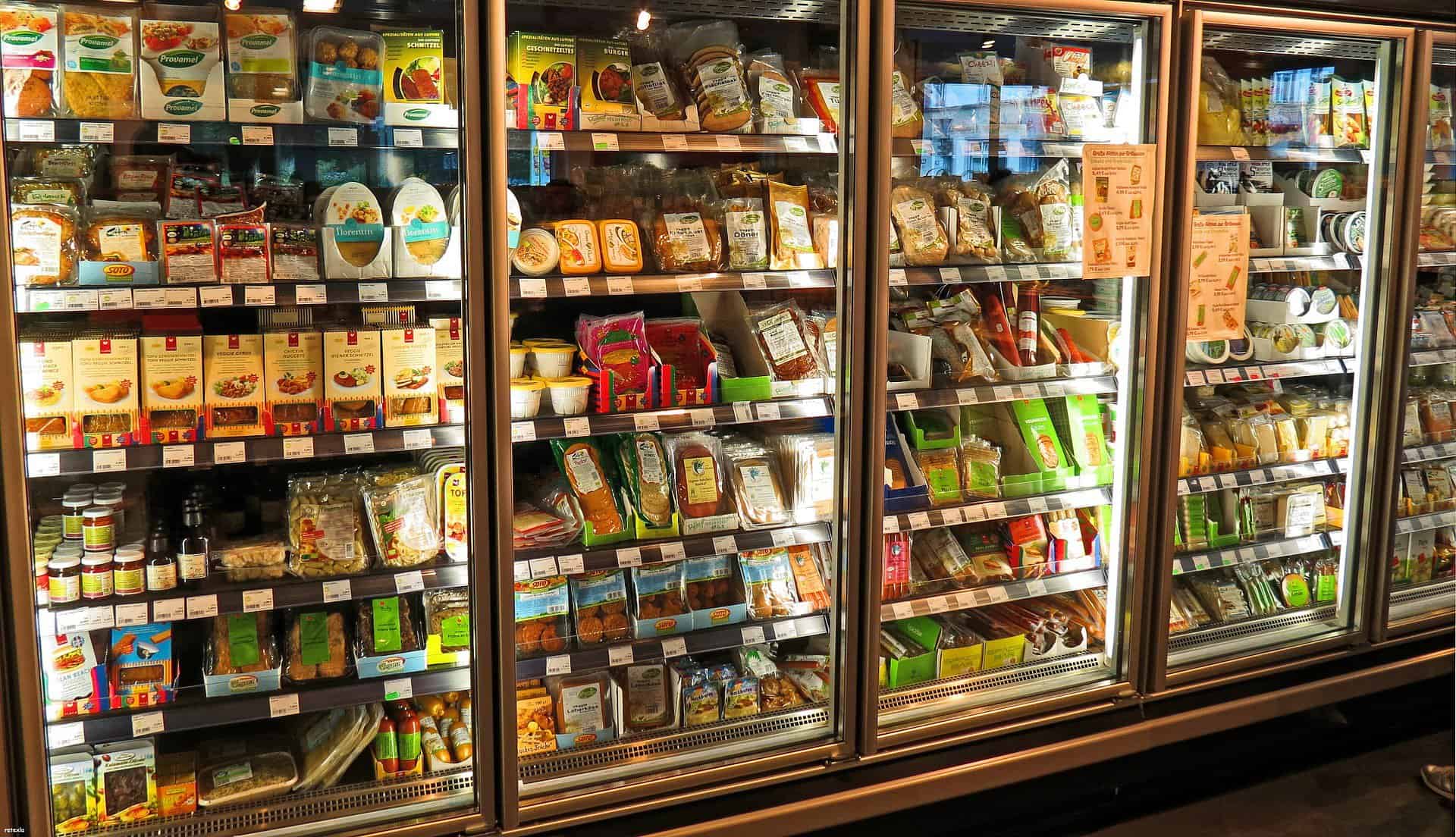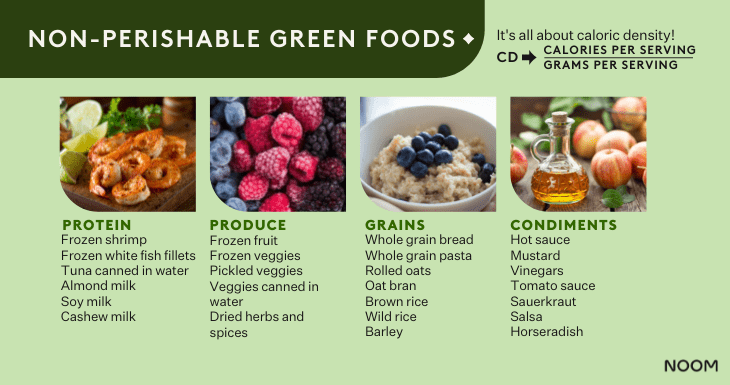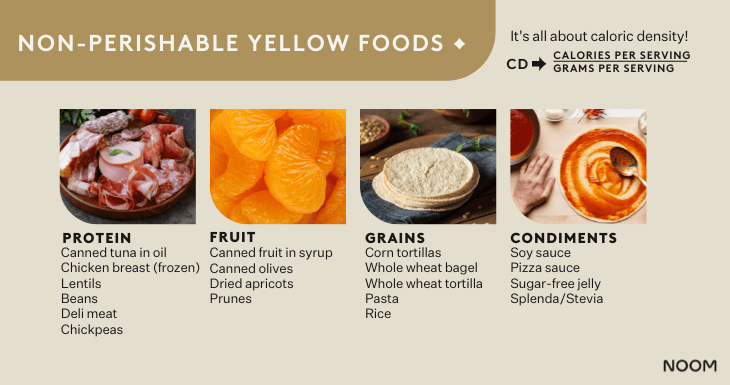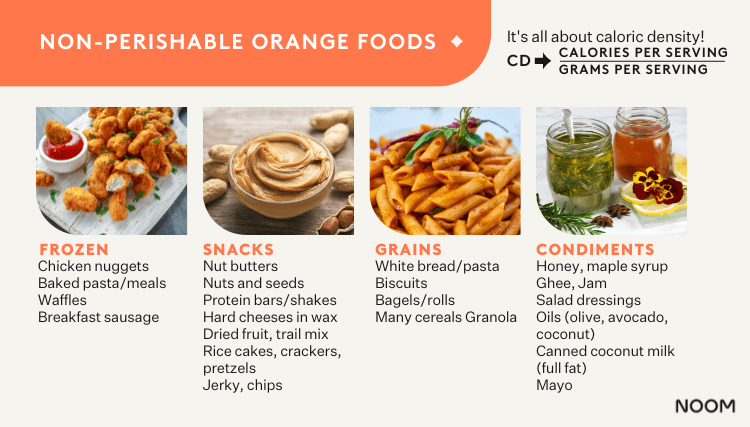Noom’s guide to healthy, shelf-stable orange, yellow, and green foods

Author: Noom Coaching Team
“If I can’t get my hands on fresh foods, there’s no way I can eat a healthy diet!” While our bodies thrive on fresh, nutrient-dense foods, we might not always have access to these. Popular to contrary belief, prepared or prepackaged food isn’t synonymous with unhealthy, and there are plenty of shelf-stable foods that can support a healthy diet.
Noom uses a unique color system that classifies foods by caloric density where green foods have the lowest caloric density, orange foods have the highest caloric density, and yellow foods fall in the middle. Our system serves as a “portion control” guide to fill up on green foods and be more mindful of portions of yellow and orange foods throughout each day.
A group of Noom Health Coaches put together a list of shelf-stable orange, yellow, and green foods to help make healthy eating simple. We’ve also added some tips along the way to help you pair and prep these foods as part of a healthy diet!
Ready to make a lasting change?
A healthier you, wherever you are.
Shelf-stable green foods
1. Frozen vegetables
Vegetables are usually frozen immediately after they are picked so they don’t lose the nutritional magic that makes them a healthy choice. Once thawed, they can be spiralized, diced, mashed (you get the point) just like fresh vegetables.
2. Canned vegetables
Canned vegetables are part of a healthy diet, as they contain many of the vitamins and minerals found in fresh produce. Due to the canning process, many vegetables take on a different texture and flavor, so get creative with recipes that provide extra flavor. Soups and stews are a great way to use canned vegetables.
3. Jarred salsa
Salsa is a great green food alternative for salad dressing and other condiments you may keep in your kitchen. Salsa can be used while cooking to add flavor without adding excessive sugar, calories, or fat to your dish. If you’re in a pinch, try making your own with canned tomatoes, a bit of salt,anddried basil (and jalapeño for a kick!)
4. Canned tuna
Canned tuna is an easy protein to add to any meal. Keep in mind that many cans of tuna sneak in 2 servings, and can be packed in water or oil (still a healthy option, but more dense). To help manage your orange food intake, it can be helpful to substitute plain, greek yogurt or mashed avocado for mayo when whipping up your favorite tuna sandwich.
5. Frozen fruits
Have you ever bought berries and gone to the fridge 3 days later and they’ve already bit the dust? We know, it might feel frustrating, but we’re here to tell you that frozen fruits can be one way around this! Frozen fruits can quickly blend into smoothies, or thaw them and add to your favorite snacks or meals.
6. Whole grain bread and pasta
Most pasta and bread are low in fat, but whole grain varieties are a good source of protein, fiber, vitamins and minerals, and yes, healthy fats. Since fresh bread won’t last you long on the shelf, try freezing a portion of your bread products for later. Stock up on whole grain pasta, which can last up to a year when stored in an airtight container or in the refrigerator!
7. Quinoa and many other whole grains
Quinoa, while technically a seed, is classified as a whole grain and a complete protein that contains all nine essential amino acids — making it a staple in our kitchens! Quinoa cooks faster than many other grains and can be used instead of rice for things like burritos, bowls, stir-frys, salads, and soups.
8. Rolled oats and bran
Oatmeal and bran are a timeless breakfast staple that babies and grandparents alike can enjoy!! When looking through the grocery store, try to avoid packaged oats that may be pre-flavored, as these can contain added sugars and artificial flavors. Instead, get creative with your flavors and toppings and check out these Oatmeal 101 recipes!
Shelf-stable yellow foods
1. Instant potatoes
Fresh potatoes have an extended shelf-life, but if you can’t get your hands on some, you can turn to instant (or boxed) potatoes. Instant potatoes serve as a great side dish and can double as a soup thickener! While there are varieties of flavors which can be prepared in many ways, all you need is water.
2. Low-sodium, canned soups
Look for low-sodium soups, which last on the shelf and can either be a standalone meal, part of a meal, or can be used as ingredients in preparing casseroles, soups, and stews. While some brands market as ready-to-go meals, don’t be afraid to add your own vegetables and/or beans to increase the nutritional value.
3. Chickpeas and other legumes
Chickpeas and other legumes are rich in protein and fiber, both of which support weight loss efforts. Fiber helps keep you fuller for longer periods of time and protein curbs hunger. Legumes are also extremely versatile. You can blend them with tahini, lemon, and garlic for a delicious hummus dip, or you can roast them with vegetables for an easy sheet-pan dinner!
4. Frozen fish
There are many benefits to choosing frozen fish, including taste, nutritional value, convenience, and price. Frozen fish, like cod or tilapia, is a convenient choice in a pinch because well-packaged fillets may not need thawing, or can be thawed quickly to cook.
5. Frozen chicken
Frozen chicken (both dark and light meat) serves as a great yellow food staple in any household freezer. There are endless possibilities on how to prepare chicken as a standalone protein or main ingredient in casseroles, soups and stews. If you prefer breaded and fried chicken, try making it at home so you have control of the ingredients and portion size!
6. Popcorn
Popcorn kernels can be purchased in bulk and last up to 2 years! Air-pop your own popcorn in the microwave; a microwave-safe bowl and plate are all you need. Treat yourself to a snack that’s packed with nutritional value and only contains the additives you choose! Use healthy seasonings that appeal to your family, such as chili powder, cinnamon, a touch of sugar or salt.
7. Whole wheat or corn tortillas
Whether you’re an expert tortilla maker or buy pre-packaged tortillas, whole wheat and corn tortillas are a great yellow substitute for fresh breads and classic packaged sandwich breads. They’re versatile in the kitchen — from #tacotuesdays and lunch wraps to baked chips — and can be plain, or seasoned to be a sweet cinnamon sugar treat!
8. White rice and pasta
When we think of shelf-stable food, rice and pasta are the first to come to mind. If stored properly, they can last six months to a year! What we love most about rice and pasta is their versatility. Prepare a few cups of dry rice on the weekend to use and season throughout the week for dishes like: gallo pinto, chicken and rice soup, and tuna rice casserole.
Shelf-stable orange foods
1. Frozen entrees
Frozen entrees (aka. “TV dinners”) can easily answer the question: “what’s for dinner?”. Frozen entrees have gotten a real “glow up” over the past decade, and now cater to a variety of particular dietary needs, so you’re bound to find options that both align with your goals and your entire family will enjoy in a pinch. As you roam the freezer aisle, compare the nutritional facts and ingredients between the options that sound good to you, keeping a close eye on sodium, added sugar, and preservatives to make the most of this orange food choice.
2. Dried beans
Dried beans are a great source of protein, dietary fiber, and complex carbs! To prepare, soak in water for 1-2+ hours (or, ideally, overnight) before cooking, to make them a little easier to digest. Dry beans take 1-2 hours to cook on the stovetop, and if you cook one large batch at a time, the cooked beans will keep well in the fridge all week long!
3. Nut butters
Nut butters serve as a great source of healthy fat! If possible, look for nut butters that contain just nuts (and maybe a little salt!). Many brands sneak in quite a bit of sugar beyond the 1-2 grams of natural sugar found in peanuts or almonds. One tablespoon typically contains 90-100 calories, so we recommend pairing a tablespoon with a green food like an apple or celery to keep your portions in check.
4. Jerky
Dried meats like beef jerky have a freakishly long shelf-life. One ounce of jerky provides 9 grams of protein — which can be a great way to stay full and energized throughout the day! Being mindful of the amount of sodium and saturated fats in your jerky choice can help you to enjoy this protein-filled snack in moderation.
5. Dried fruits
Like dried meats, dried fruits can sit in your pantry for a long time! Though dried fruit offers the same vitamins and minerals as fresh fruit, dried fruits are much more calorie dense, so be mindful of portion size!
6. Crackers
Crackers are a great side for a soup or salad, or a snack on their own with cheese or hummus. Look for whole grain crackers that are higher in fiber and low in sodium for a healthier option.
7. Biscuits and bagels
Biscuits and bagels are typically higher in calories than other breads or whole grain products, but like with anything, it’s all about moderation. To extend their shelf life, try storing them in the freezer.
8. Protein powders
Most protein powders have a long shelf life and are versatile. Mix your protein powder of choice with other pantry and freezer staples such as frozen fruit, frozen spinach, nut butter, and cinnamon for a delicious smoothie that the whole family will love!
At the end of the day, in periods of uncertainty, when access to food may be limited ,your first priority should be making sure your basic physical needs are met — getting enough food and staying hydrated. Then, if you have the privilege to think about food quality, use this as your guide.
How to Stock a Pantry
A well-stocked kitchen includes three parts: the cupboard, the fridge, and the freezer. Here are some great options!
In the cupboard:
* Grains and pasta: whole rolled oats, quinoa, rice, whole wheat pasta
* Canned produce: Whole peeled tomatoes, diced fire roasted tomatoes, pumpkin puree, corn, green beans
* Protein: canned and dried lentils, chickpeas, beans, canned fish
* Fats: extra-virgin olive oil, coconut oil, toasted sesame oil, nuts, seeds, nut butters, coconut milk
* Dried fruit: dried tart cherries, apricots, dates, raisins
* Baking ingredients and spices: sea salt, black pepper, cumin, coriander, cinnamon, cardamom, smoked paprika, red pepper flakes, sugar, brown sugar, flour, baking soda, baking powder, active dry yeast
In the freezer:
* Frozen vegetables and fruit: peas, spinach, broccoli, carrots, green beans, squash, cauliflower, berries, mango, pineapple
* Bread and tortillas: whole wheat bread, flour and corn tortillas/wraps
* Protein: ground/whole poultry and beef, fish
* A few freezer meals: next time you cook, freeze any leftovers, or make a double batch, and freeze the extras!
In the fridge:
* Long-lasting fresh produce: potatoes, sweet potatoes, onions, garlic, winter squash, cabbage, root veggies, lemons, limes
* Protein: tofu, tempeh, deli meats
* Dairy and eggs: cheeses, Greek yogurt, eggs
* Flavorful extras: mustard, sun-dried tomatoes, olives, capers, pickled vegetables, tamari, vinegars
You don’t need to keep all these ingredients on hand all the time, of course. But with a mix of a few items from each category, you’ll be on your way to making all sorts of delicious meals!
Reverse Meal Planning (taken from a post in the Goal Specialists slack channel):
A sample shopping list might include:
- 3-4 proteins
- 3-5 canned/frozen veggies
- 3-5 fresh veggies (or more frozen fruit / veggies)
- 2-3 frozen/fresh fruits
- 2-3 rice, oatmeal, other grains, dried beans, potatoes, squash
- 2-3 dairy / eggs
- optional: condiments, dried herbs / spices
Non-perishable Green Foods
It’s all about caloric density!
CD = Calories per serving / Grams per serving
| Protein | Produce | Grains | Condiments |
|---|---|---|---|
| Frozen shrimp | Frozen fruit | Whole grain bread | Hot sauce |
| Frozen white fish fillets | Frozen veggies | Whole grain pasta | Mustard |
| Tuna canned in water | Pickled veggies | Rolled oats | Vinegars |
| Almond milk | Veggies canned in water | Oat bran | Tomato sauce |
| Soy milk | Dried herbs and spices | Brown rice | Sauerkraut |
| Cashew milk | Wild rice | Salsa | |
| Barley | Horseradish |

Non-Perishable Yellow Foods
It’s all about caloric density!
CD = Calories per serving / Grams per serving
| Protein | Fruit | Grains | Condiments |
|---|---|---|---|
| Canned tuna in oil | Canned fruit in syrup | Corn tortillas | Soy Sauce |
| Chicken breast (frozen) | Canned olives | Whole wheat bagel | Pizza sauce |
| Lentils | Dried apricots | Whole wheat tortilla | Sugar free jelly |
| Beans | Prunes | Pasta | Spenda/Stevia |
| Deli meat | Rice | ||
| chickpeas |

Non-perishable Orange Foods
It’s all about caloric density
CD = Calories per serving / Grams per serving
| Frozen | Snacks | Grains | Condiments |
|---|---|---|---|
| Chicken nuggets | Nut butters | White bread/pasta | Honey, maple syrup |
| Baked pasta/meals | Nuts and seeds | Biscuits | Ghee, jam |
| Waffles/Breakfast sausage | Protein bars/shakes | Bagels/rolls | Salad dressings |
| Hard cheeses in wax | Many cereals/Granola | Oils (olive, avocado, coconut) | |
| Rice cakes, crackers, pretzels | Mayo | ||
| Jerky, chips | |||

Get started today
If you’re looking for support in navigating your health goals, kickstart your 14-day Noom trial today!

